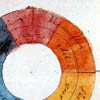

Colours are the deeds of light; its deeds and sufferings: thus considered we may expect from them some explanation respecting light itself.
DESCRIPTION
The cptclip utility extracts a sub-table from
a cpt format file. The arguments to the mandatory --range option,
min/max,
are interpreted as the (z) limits of the output unless the --segments switch is specified, in which case they are the segment numbers.
If the input has a hinge and the selected clipping range does not include that hinge, then it will be removed in the output.
The program will read from stdin if a file is not specified as
the final argument, and write to stdout if the --output option is not specified.
Note that some of the functionality of this program is included in recent versions of the GMT program makecpt (1) .
OPTIONS
--backtrace-filepath-
Specify a file to which to write a formatted backtrace. The file will only be created if there is a backtrace created, typically when an error occurs.
--backtrace-formatformat-
Specify the
formatof the backtrace written to the files specified by--backtrace-file, one ofplain,xmlorjson. -h,--help-
Brief help.
--hingevalue-
Specify the z-
valueof the hinge in the cpt file. If there is no hinge directive (i.e., aSOFT_HINGEorHARD_HINGE) in the input, then this option has no effect.When normalising (with the
--z-normaliseoption), this gives the z-value in the input which is mapped to zero. That z-value must be one of the stops in the input.When denormalising (with the
--z-denormaliseoption), this gives the value in the output to which zero in the input is mapped. This option can be viewed as the counterpart to the+happended to thevalue-Coption for the makecpt (1) . --hinge-active-
If the input cpt has a
SOFT_HINGEdirective, then activate that hinge (resulting in independent scaling of the two halves of the gradient either side of the hinge).If the input does not have such a directive, then this option has no effect.
-o,--outputpath-
Write the output to
path, rather thanstdout. -R,--rangemin/max-
The (z) range of the output, or the segments if the
--segmentsswitch is also given. -s,--segments-
The
minandmaxarguments of the--rangeswitch are interpreted as the segment numbers (starting at one). -v,--verbose-
Verbose operation.
-V,--version-
Version information.
-z,--z-normalise-
Normalise the z-values in the cpt output into the range 0/1 (or to -1/1 if a hinge is present) and add a
RANGEdirective if not present in the input. This is the form used in GMT master files.This option requires that output cpt version is at least 5.
-Z,--z-denormalise-
Set the z-values in the cpt output into the range given by the
RANGEdirective, and remove that directive. If there is noRANGEthen this option does nothing. -4,--gmt4-
Use GMT 4 conventions when writing the cpt output: the colour-model code is uppercase, and the colours are separated by spaces.
This is incompatible with the
-5and-6options of course.At present this option is the default, but that will change at some point. So specify this option if your use of the output depends on the GMT 4 layout (consumed by a custom parser, for example).
-5,--gmt5-
Use GMT 5 conventions when writing the cpt output: the colour-model code is lowercase, and the colours are separated by a solidus for RGB, CMYK, by a dash for HSV.
This is incompatible with the
-4and-6options of course. -6,--gmt6-
As the
-5option, but allows theHARD_HINGEandSOFT_HINGEdirectives in place of the explicitHINGE =directive.This is incompatible with the
-4and-5options of course.